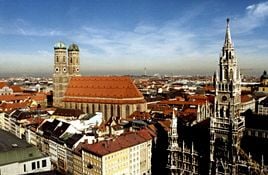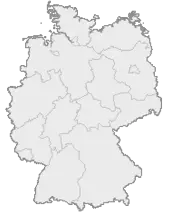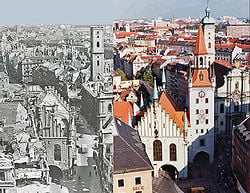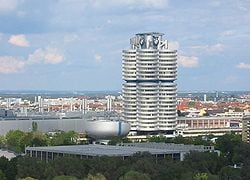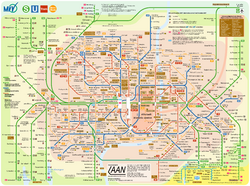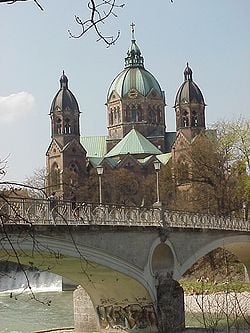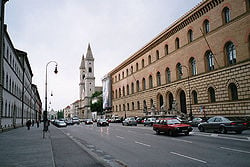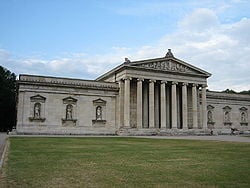Munich
| München Munich | |
| Coordinates | |
| Administration | |
| Country | Germany |
|---|---|
| State | Bavaria |
| Admin. region | Upper Bavaria |
| District | Urban district |
| City subdivisions | 25 boroughs |
| Lord Mayor | Christian Ude (SPD) |
| Governing parties | SPD / Greens / Rosa Liste München |
| Basic statistics | |
| Area | 310.43 km² (119.86 sq mi) |
| Elevation | 519 m (1703 ft) |
| Population | 1,494,608 (31 December 2006)[1] |
| - Density | 4,815 /km2 (12,470 /sq mi) |
| - Urban | 2,600,000 |
| - Metro | 6,000,000 |
| Founded | 1158 |
| Other information | |
| Time zone | CET/CEST (UTC+1/+2) |
| Licence plate | M |
| Postal codes | 80331–81929 |
| Area code | 089 |
| Website | www.muenchen.de |
Munich (German: München, German pronunciation: [ˈmʏnçən] listen ▶; Austro-Bavarian: Minga[2]) is the capital city of Bavaria, Germany. Munich is located on the River Isar north of the Bavarian Alps. Munich is the third largest city in Germany. Ahead of it are Berlin and Hamburg. There are approximately 1.35 million inhabitants within Munich.[3]
The city's motto is "München Mag Dich" ("Munich Likes You"), before 2006 it was "Weltstadt mit Herz". Black and gold - the colours of the Holy Roman Empire - have been the city's official colours since the time of Ludwig the Bavarian.
Munich is not the only location within Bavaria known as "München". Three such locations exist: the one which is known as "Munich"; another which is northeast of the city of Nuremberg; and also a town north of the city of Passau.
The former Dachau concentration camp is 16 kilometres outside the city.
Geography
Its native name, München, is derived from the Old German word for Mönche, which means "Monks" in English. Munich was the “home of the monks”, and is the reason a monk appears on the city's coat of arms.
Munich lies on the elevated plains of Upper Bavaria, about 50km north of the northern edge of the Alps, in the Northern Alpine Foreland, at an altitude of about 520 meters. The northern part of this sandy plateau includes a highly fertile flint area, while the southern part is covered by morainic hills. In between there are fields of fluvio-glacial out-wash, like around Munich. Wherever these deposits get thinner, the ground water can permeate the gravel surface and flood the area, leading to marshes as in the north of Munich.
Munich has a continental climate, strongly modified by the proximity of the Alps. Winters last from December to March. The coldest month is January with an average temperature of 30°F (-2°C). Snow cover is seen for a couple of weeks during winter. Summers are fairly warm with average temperature of 70°F (19°C) in July. The summers last from May until September. The range of temperature between day and night can be extreme. A warm downwind from the Alps (a föhn wind) can change the temperatures within a few hours, even in the winter. Another weather condition known as Alpenstau occurs, most often in spring and summer, which brings unseasonably low temperatures, rain and even snow. The city's altitude and proximity to the northern edge of the Alps mean that precipitation is rather high. Mean annual precipitation is 32 inches (810mm).
The local rivers are the Isar and the Würm.
Size – land area, size comparison
Environmental pollution is comparatively low, although as of 2006 the city council was concerned about levels of particulate matter (PM), especially along the city's major thoroughfares. Environmental groups such as Greenpeace have staged large protest rallies to urge the city council and the State government to take a harder stance on pollution.
Districts
History
Hunters and gatherers populated German forests about 400,000 years ago. Around 4500 B.C.E., farming peoples from south-west Asia migrated up the Danube Valley. Tegernsee Abbey was founded in 746 by Benedictine monks. Located 50km south of Munich, it had a substantial influence on development of Southern Bavaria. By 1158, the Guelph Henry the Lion, Duke of Saxony and Bavaria, had built a toll bridge over the river Isar next to the abbey, on the Salt Route. This is the earliest date the name “Munich” appeared in a document.
City status
In 1175, Munich was officially granted city status and was fortified. In 1180, Otto I Wittelsbach became Duke of Bavaria, and Munich was handed over to the Bishop of Freising. Otto's heirs, the Wittelsbach dynasty would rule Bavaria until 1918. In 1240, Munich itself was transferred to Otto II Wittelsbach and in 1255, when the Duchy of Bavaria was split in two, Munich became the ducal residence of Upper Bavaria.
Duke Louis IV was elected German king in 1314 and crowned as Holy Roman Emperor in 1328. He strengthened the city's position by granting it the salt monopoly, thus assuring it of additional income. In the late 15th century Munich underwent a revival of gothic arts - the Old Town Hall was enlarged, and a new cathedral - the Frauenkirche - constructed within only 20 years, starting in 1468.
Center of Counter Reformation
Munich became capital when Bavaria was reunited in 1506. During the 16th century Munich was a center of the German Counter Reformation, and also of Renaissance arts. Duke Wilhelm V commissioned the Jesuit Michaelskirche, which became a center for the Counter-Reformation, and also built the Hofbräuhaus, for brewing brown beer in 1589.
The Catholic League was founded in Munich in 1609. In 1623, during the Thirty Years' War (1618-1648), Munich prospered when Maximilian I, Duke of Bavaria became elector, but in 1632 the city was occupied by Gustav II Adolph of Sweden. When the bubonic plague broke out in 1634 and 1635 about one third of the population died. Under the regency of the Bavarian electors Munich was an important center of baroque life but also had to suffer under Habsburg occupations in 1704 and 1742.
In 1806, the city became the capital of the new Kingdom of Bavaria, with the state's parliament (the Landtag) and the new archdiocese of Munich and Freising being located in the city. Twenty years later Landshut University was moved to Munich. Many of the city's finest buildings belong to this period and were built under the first three Bavarian kings.
Louis I, who was king of Bavaria from 1825 to 1848, created the city’s characteristic appearance. Louis II promoted the composer Richard Wagner, and revived Munich’s fame as a city of music.
World War I
Following the outbreak of World War I in 1914, life in Munich became difficult, as the Allied blockade of Germany led to food and fuel shortages. During French air raids in 1916 three bombs fell on Munich. After World War I, the city was at the centre of much political unrest. In November 1918 on the eve of revolution, Ludwig III and his family fled the city. After the murder of the first republican premier of Bavaria Kurt Eisner in February 1919 by Anton Graf von Arco-Valley, the Bavarian Soviet Republic was proclaimed. When Communists had taken power, Lenin, who had lived in Munich some years before, sent a congratulatory telegram, but the Soviet Republic was put down on May 3, 1919, by the Freikorps. While the republican government had been restored, Munich subsequently became a hotbed of right-wing politics, among which Adolf Hitler and the National Socialism rose to prominence.
Nazi stronghold
In 1923, Hitler and his supporters, who at that time were concentrated in Munich, staged the Beer Hall Putsch, an attempt to overthrow the Weimar Republic and seize power. The revolt failed, resulting in Hitler's arrest and the temporary crippling of the Nazi Party, which was virtually unknown outside Munich. The city would once again become a Nazi stronghold when the National Socialists took power in Germany in 1933. The National Socialist Workers Party created the first concentration camp at Dachau, 10 miles (16 km) north-west of the city. Munich was referred to as the Hauptstadt der Bewegung ("Capital of the Movement"). The NSDAP headquarters were in Munich and many Führerbauten ("Führer-buildings") were built around the Königsplatz, some of which have survived.
World War II
The city is known as the site of the culmination of the policy of appeasement employed by Britain and France leading up to World War II. It was in Munich that British Prime Minister Neville Chamberlain assented to the annexation of Czechoslovakia's Sudetenland region into Greater Germany in the hopes of sating the desires of Hitler's Third Reich. Munich was the base of the White Rose, a group of students that formed a resistance movement from June 1942 to February 1943. The core members were arrested and executed following a distribution of leaflets in Munich University by Hans and Sophie Scholl. A total of 71 Allied air raids over six years heavily damaged Munich during World War II.
Munich rebuilt
After American occupation in 1945, Munich was rebuilt following a meticulous plan which preserved its pre-war street grid. In 1957, Munich's population passed the 1 million mark. Munich was the site of the 1972 Summer Olympics, when gunmen from the Palestinian "Black September" group took hostage members of the Israeli Olympic team, killing some.
Government
Germany is a federal republic in which the president is the chief of state elected for a five-year term by members of the Federal Assembly and by delegates elected by the state parliaments. The chancellor, who is head of government, is elected by an absolute majority of the Federal Assembly for a four-year term. The bicameral parliament consists of the Bundestag of 614 members elected by popular vote under a combination of direct and proportional representation. In the Bundesrat, of 69 votes, state governments are directly represented by votes proportional to population.
Munich's current mayor is Christian Ude of the Social Democratic Party of Germany. Munich has a nearly unbroken history of SPD governments since World War II, which is remarkable because the rest of Bavaria is a conservative stronghold, with the Christian Social Union winning absolute majorities among the Bavarian electorate in many elections at the communal, state, and federal levels.
As capital of the Free State of Bavaria, Munich is an important political centre in Germany and the seat of the Bavarian State Parliament, the Staatskanzlei (the State Chancellery) and of all state departments.
Several national and international authorities are located in Munich, including the German Tax Court and the European Patent Office.
Subdivisions
Since the administrative reform in 1992, Munich is divided into 25 boroughs or Stadtbezirke.
Economy
Munich has the strongest economy of any German city,[4] as well as the lowest unemployment rate (5.6 %) of any German city with more than a million people (the other ones being Berlin and Hamburg).[5] The city is also the economic centre of southern Germany. The initiative “Neue Soziale Marktwirtschaft (INSM)” (New Social Market Economy) and the “WirtschaftsWoche” (Business Weekly) magazine have awarded Munich the top score in their comparative survey for the third time in June 2006. Munich topped the ranking of the magazine “Capital” in February 2005 for the economic prospects between 2002 and 2011 in sixty German cities. Munich is considered a global city and holds the headquarters of Siemens AG (electronics), BMW (car), MAN AG (truck manufacturer, engineering), Linde (gases), Allianz (insurance) and Munich Re (re-insurance). Among German cities with more than 500,000 inhabitants purchasing power is highest in Munich (26,648 Euros per inhabitant) as of 2007.[6] In 2006, Munich blue-collar workers enjoyed an average hourly wage of 18.62 Euros (ca. $ 23)[7].
The breakdown by cities proper (not metropolitan areas) of Global 500 cities listed Munich in 9th position in 2008 [8]. Munich is also a centre for biotechnology, software and other service industries. Munich is also the home of the headquarters of many other large companies like the aircraft engine manufacturer MTU Aero Engines, the space and defence contractor EADS (headquartered in the suburban town of Ottobrunn), the injection molding machine manufacturer Krauss-Maffei, the camera and lighting manufacturer Arri, the semiconductor firm Infineon Technologies (headquartered in the suburban town of Neubiberg), the DRAM company Qimonda, as well as the German or European headquarters of many foreign companies like Precision Plus, McDonald’s and Microsoft.
Munich has significance as a financial centre (secondary to Frankfurt), being home of HypoVereinsbank and the Bayerische Landesbank. It outranks Frankfurt though as home of insurance companies like Allianz and Munich Re.
Munich is the largest publishing city in Europe[9] and home to the Süddeutsche Zeitung, one of Germany's largest daily newspapers. Munich is also home to Germany's largest public broadcasting network, ARD, and its largest commercial network, Pro7-Sat1 Media AG, and is also host to the Burda publishing group.
The Bavaria Film Studios are located in the suburb of Grünwald. They are one of Europe's biggest and most famous film production studios.[10]
The majority of residents of Munich enjoy a high quality of life. Mercer HR Consulting consistently rates the city among the top 10 cities with highest quality of life worldwide - a 2007 survey ranked Munich as 8th.[11] The same company also ranks Munich as the world's 39th most expensive city to live in and the most expensive major city in Germany.[12] Munich enjoys a thriving economy, driven by the information technology, biotechnology, and publishing sectors Today, the crime rate is very low compared to other large German cities, such as Hamburg or Berlin.[13] This high quality of life and safety has caused the city to be nicknamed "Toytown" amongst the English-speaking residents. German inhabitants call it "Millionendorf", a mildly derogatory expression which means "village of a million people".
Transportation
High speed trains connect Munich to the main cities of Germany and Austria. Munich is an integral part of the motorway network of southern Germany. Motorways from Stuttgart, Berlin, Frankfurt, Lindau, Garmisch Partenkirchen and Salzburg terminate at Munich. The city and its closest suburbs have one of the most comprehensive public transport systems in the world, incorporating the Munich U-Bahn (underground railway), the Munich S-Bahn (suburban trains), trams and buses. Bicycle lanes are widely used, and a modern bike hire system is available in the central area. Franz Josef Strauss International Airport is Germany's second largest airport, with about 34 million passengers a year, and lies some 30 km (19 mi) north east of the city centre.
Demographics
Population, population rank Munich is the third-largest city in Germany in terms of inhabitants after Berlin and Hamburg. Munich had 1.34 million inhabitants in July 2007, of which 300,129 did not hold German citizenship.
Race/ethnicity - historical background of ethnic groups Language Religion Colleges and universities
At 23 percent, the immigrant population is higher than the national average. The city has strong Turkish and Balkan communities. The largest groups of foreign nationals were Turks (43,309), Albanians (30,385), Croats (24,866), Serbs (24,439), Greeks (22,486), Austrians (21,411), and Italians (20,847). About 37 percent of foreign nationals come from the European Union.
With only 24,000 inhabitants in 1700, the population doubled roughly every 30 years. For example, it had 100,000 people in 1852 and then 250,000 people in 1883; by 1901, the figure had doubled again to 500,000. Since then, Munich has become Germany's third largest city. In 1933, 840,901 inhabitants were counted and in 1957, Munich's population passed the 1 million mark.
39.5% of inhabitants are Roman Catholic and 14.2% Protestant (as of 31 December 2005).
Colleges and Universities
Munich is a leading location for science and research with a long list of Nobel Prize laureates from Wilhelm Conrad Röntgen in 1901 to Theodor Hänsch in 2005. Munich has become a spiritual centre already since the times of Emperor Louis IV when philosophers like Michael of Cesena, Marsilius of Padua and William of Ockham were protected at the emperor's court. Both the universities of the Bavarian metropolis, the Ludwig Maximilian University (LMU) and the Technical University (TU or TUM), were found to be worthy of the title of elite university by the selection committee, which consisted of academics and members of the Ministries of Education and Research of the Federation and the German states (Länder). Only Munich's two universities and the Technical University of Karlsruhe have been awarded already in 2006 the title of elite university of Germany and millions of euro in funding.
- University of Munich (LMU), founded in 1472 in Ingolstadt, moved to Munich in 1826
- Technical University of Munich (TUM), founded in 1868
- Munich Business School (MBS), founded in 1991
- Munich University of Applied Sciences (HM), founded in 1971
- Munich Intellectual Property Law Center (MIPLC)
- University of the German Federal Armed Forces, Munich, founded in 1972
- Pionierschule und Fachschule des Heeres für Bautechnik
- Hochschule für Musik und Theater München, founded in 1830
- Akademie der Bildenden Künste München, founded in 1808
- University of Television and Film Munich, (Hochschule für Fernsehen und Film)founded in 1966
- Hochschule für Philosophie München, founded in 1925 in Pullach, moved to Munich in 1971
- Hochschule für Politik München
- Katholische Stiftungsfachhochschule München, founded in 1971
- International Max Planck Research School for Molecular and Cellular Life Sciences[5],
- European School of Management and Technology (esmt)
- Deutsche Journalistenschule, founded in 1959
Scientific research institutions
Max Planck Society
The Max Planck Society, an independent German non-profit research organization, has its administrative headquarters in Munich. The following institutes are located in the Munich metropolitan area:
- Max Planck Institute for Astrophysics, Garching
- Max Planck Institute of Biochemistry, Martinsried
- Max Planck Institute for Extraterrestrial Physics, Garching
- Max Planck Institute for Foreign and International Social Law, München
- Max Planck Institute for Intellectual Property, Competition and Tax Law, München
- Max Planck Institute of Neurobiology, Martinsried
- Max Planck Institute for Ornithology, Andechs-Erling (Biological Rhythms and Behaviour), Radolfzell, Seewiesen (Reproductive Biology and Behaviour)[6]
- Max Planck Institute for Physics (Werner Heisenberg Institute), München
- Max Planck Institute for Plasma Physics, Garching and Greifswald
- Max Planck Institute of Psychiatry, München
- Max Planck Institute for Psychological Research, München
- Max Planck Institute of Quantum Optics, Garching
Other research institutes
- Fraunhofer Institute
Of interest
Munich has long been a centre for fine architecture, the arts, especially music.
Architecture
At the centre of the city is the Marienplatz - a large open square named after the Mariensäule, a Marian column in its centre - with the Old and the New Town Hall. Its tower contains the Rathaus-Glockenspiel. Three gates of the demolished medieval fortification have survived - the Isartor in the east, the Sendlinger Tor in the south and the Karlstor in the west of the inner city. The Karlstor (destroyed during the Second World War and rebuilt afterwards) leads up to the Stachus, a grand square dominated by the Justizpalast (Palace of Justice) and a fountain.
The Peterskirche close to Marienplatz is the oldest church of the inner city. It was the focus of the early monastic settlement in Munich before the city's official foundation in 1158. Nearby, the Gothic hall-church Heiliggeistkirche (The Church of the Holy Spirit) was converted to baroque style from 1724 onwards and looks down upon the Viktualienmarkt, the most popular market of Munich.
The Frauenkirche is the most famous building in the city centre and serves as cathedral for the Archdiocese of Munich and Freising. The nearby Michaelskirche is the largest renaissance church north of the Alps, while the Theatinerkirche is a basilica in Italianate high baroque which had a major influence on Southern German baroque architecture. Its dome dominates the Odeonsplatz.
The large Residenz palace complex (begun in 1385) on the edge of Munich's Old Town ranks among Europe's most significant museums of interior decoration. It contains the treasury and the splendid rococo Cuvilliés Theatre. Next door is the neo-classical opera, the National Theatre. Baroque and neoclassical mansions include the Palais Porcia, the Palais Preysing, the Palais Holnstein and the Prinz-Carl-Palais.
Four grand 19th century royal avenues with magnificent official buildings connect Munich's inner city with the suburbs. They are: The neoclassical Briennerstraße, which begins at Odeonsplatz and runs from east to west and opens into the impressive Königsplatz; Ludwigstraße , which also begins at Odeonsplatz and runs from south to north; the neo-Gothic Maximilianstraße starts at Max-Joseph-Platz, where the Residenz and the National Theatre are situated, and runs from west to east; and Prinzregentenstraße, which runs parallel to Maximilianstraße and begins at Prinz-Carl-Palais.
Two large baroque palaces are reminders of Bavaria's royal past. Nymphenburg Palace, some 6 km north west of the city centre, is surrounded by an impressive park and is considered to be one of Europe's most beautiful royal residences. Two kilometers north west is Blutenburg Castle, an old ducal country seat with a late-Gothic palace church. Fürstenried Palace is a baroque palace similar to Nymphenburg but much smaller, and Schleissheim Palace, located in the suburb of Oberschleissheim, is a palace complex encompassing three separate residences.
Most boroughs have parish churches which originate from the Middle Ages like the most famous church of pilgrimage in Munich St Mary in Ramersdorf. The oldest church within the city is Heilig Kreuz in Fröttmaning next to the Allianz-Arena, known for its Romanesque fresco.
Most high-rise buildings are clustered at the northern edge of Munich in the skyline, like the Hypo-Haus, the Arabella High-Rise Building, the Highlight Towers, Uptown Munich, Münchner Tor and the BMW Headquarters next to the Olympic Park.
Munich has numerous parks. The Englischer Garten, close to the city centre and covering an area of 3.7 km² (larger than Central Park in New York), is one of the world's largest urban public parks, and contains a nudist area, jogging tracks and bridle-paths. The city's oldest park is the Hofgarten, near the Residenz, and dating back to the 16th century. Most known for the largest beergarden in the town is the former royal Hirschgarten, founded in 1780 for deer which still live there. The city's zoo is the Tierpark Hellabrunn in the south of the city.
Museums
The German Museum, located on an island in the River Isar, is one of the oldest and largest science museums in the world. Its flight exhibition centre is located nearby, on the Schleißheim Special Landing Field. Several non-centralised museums show the expanded state collections of palaeontology, geology, mineralogy, zoology, botany and anthropology. The State Museum of Ethnology is the second largest collection in Germany of artifacts and objects from outside Europe, while the Bavarian National Museum and the adjoining Bavarian State Archaeological Collection rank among Europe's major art and cultural history museums.
Art galleries include the Alte Pinakothek, the Neue Pinakothek, and the Pinakothek der Moderne. Alte Pinakothek's rather monolithic structure contains a treasure trove of the works of European masters between the 14th and 18th centuries. An important collection of Greek and Roman art is held in the Glyptothek and the Staatliche Antikensammlung (State Antiquities Collection). The nearby Schackgalerie is an important gallery of German 19th century paintings.
Oktoberfest
The Hofbräuhaus am Platzl, arguably the most famous beer hall worldwide, is located in the city centre. It also operates the second largest tent at the Oktoberfest, one of Munich's most famous attractions. For two weeks, the Oktoberfest, attracts millions of people visiting its beer tents ("Bierzelte") and fairground attractions. The Oktoberfest was first held on October 12, 1810, to honour the marriage of crown prince Ludwig to Princess Therese von Sachsen-Hildburghausen. Despite its name, most of Oktoberfest occurs in September. It usually finishes on the first Sunday in October.
Munich is famous for its breweries and the Weißbier (or Weizenbier, wheat beer) is a speciality from Bavaria. Helles with its translucent gold colour is the most popular Munich beer today, although it’s not very old (only introduced in 1895). Helles and Pils have almost ousted the Munich Dark Beer (Dunkles), which gets its dark colour from burnt malt. Starkbier is the strongest Munich beer, containing 6–9 percent alcohol.
Sport
Munich is home to several professional football teams, including 1860 Munich and FC Bayern Munich. The Munich area has three teams in the Bundesliga system, which comprises the three top divisions of German football. The city's hockey club is EHC Munich.
Around Munich
The Munich agglomeration sprawls across the plain of the Alpine foothills comprising about 2.6 million habitants. Several smaller traditional Bavarian towns and cities like Dachau, Freising, Erding, Starnberg, Landshut and Moosburg are today part of the Geater Munich Region formed by Munich and the surrounding districts making up the metropolitan area of about 4.5 million people.
- StadtpfarrkircheStJakob.JPG
Dachau
- Erding center.JPG
Erding
- Freisinger Dom aussen 01.jpg
Freising
- Cloister Fuerstenfeld Portal.jpg
Fürstenfeldbruck
- Landsberg Befestigung 4.jpg
Landsberg
- Kastulusmünsterp.jpg
Moosburg
ReferencesISBN links support NWE through referral fees
- ↑ Bayerisches Landesamt für Statistik und Datenverarbeitung. www.statistik.bayern.de (in German). Retrieved 2008-05-17.
- ↑ Names of European cities in different languages#M
- ↑ http://www.region-muenchen.com/themen/info_en/info_en.htm Region Munich
- ↑ [1] Study conducted by INSM (New Social Market Economy Initiative) and WirtschaftsWoche magazine
- ↑ [2] Bundesagentur für Arbeit (Federal agency for work)
- ↑ [3] Germany, statistics, studies, consumers
- ↑ Landeshauptstadt München, Direktorium, Statistisches Amt: Statistisches Jahrbuch 2007, page 206 (Statistical Yearbook of the City of Munich 2007)
- ↑ [4] Fortune Global 500 annual ranking of the world's largest corporations
- ↑ Munich Literature House: About Us. Retrieved February 17, 2008.
- ↑ Bavaria Film GmbH. Retrieved February 17, 2008.
- ↑ 2007 survey Mercer Human Resource Consulting
- ↑ 2007 Cost of Living Report Munich Mercer Human Resource Consulting
- ↑ Report in Stern magazine (German)
Further reading
External links
- Munich as a business hub Retrieved August 31, 2008.
- Münchner Verkehrs- und Tarifverbund Public transport, retrieved August 31, 2008.
- Toytown Munich Community website, retrieved August 31, 2008.
- Europe Pictures - Munich
- Geocoded Pictures of Munich
- Munich City Panoramas - Panoramic Views and virtual Tours
- Tales from Toytown - Photos of Munich
- A Photo-Enthusiasts View of Munich
Credits
New World Encyclopedia writers and editors rewrote and completed the Wikipedia article in accordance with New World Encyclopedia standards. This article abides by terms of the Creative Commons CC-by-sa 3.0 License (CC-by-sa), which may be used and disseminated with proper attribution. Credit is due under the terms of this license that can reference both the New World Encyclopedia contributors and the selfless volunteer contributors of the Wikimedia Foundation. To cite this article click here for a list of acceptable citing formats.The history of earlier contributions by wikipedians is accessible to researchers here:
The history of this article since it was imported to New World Encyclopedia:
Note: Some restrictions may apply to use of individual images which are separately licensed.
